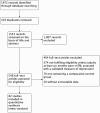Characterizing the Risk of Depression Following Mild Traumatic Brain Injury: A Meta-Analysis of the Literature Comparing Chronic mTBI to Non-mTBI Populations
- PMID: 32508733
- PMCID: PMC7248359
- DOI: 10.3389/fneur.2020.00350
Characterizing the Risk of Depression Following Mild Traumatic Brain Injury: A Meta-Analysis of the Literature Comparing Chronic mTBI to Non-mTBI Populations
Abstract
Objective: Mild traumatic brain injury (mTBI) is associated with depressed mood acutely post-injury, but there is little evidence regarding long-term depression. The aim of this study was to determine the odds ratio (OR) of depression chronically following mTBI. Methods: We searched Medline (PubMed), ProQuest, and Web of Science from date of database creation to January 23, 2019, for eligible studies examining depression at least 6 months post-injury in adult subjects with mTBI of any etiology, including civilians and military. Three authors independently reviewed titles and abstracts for study eligibility. Data were extracted and collated by two investigators. Risk of bias was assessed with the SIGN methodology. Study data were pooled using random-effects meta-analysis. The primary exposure was mTBI, and the primary outcome was depression. Secondary exploratory variables were time of assessment, age at injury, age at assessment, sex, and etiology. Results: We included 47 cross-sectional studies (n = 25,103 mTBI and 29,982 control), 26 cohort studies (n = 70,119 mTBI, 262,034 control), four prospective observational studies (n = 1,058 mTBI and 733 control), two prospective longitudinal studies (n = 119 mTBI, 81 control), two case-control studies (n = 56 mTBI, 56 control), and one randomized controlled trial (n = 252 mTBI, 3,214 control). mTBI was associated with a 3.29-fold increased risk of depression (OR 3.29, 95% CI 2.68-4.03, I 2 = 96%). The OR for depression did not change when subjects were assessed at 6-12 months (OR 2.43, 1.45-4.07), years 1-2 (OR 4.12, 2.10-8.07); 2-10 (OR 3.28, 2.42-4.46), or 10+ (OR 3.42, 1.51-7.77). Similar risk of depression was sustained across different age at injury (<25: OR 2.26, 1.82-2.81; 25-35: OR 4.67, 3.06-7.14; >35: OR 2.69, 1.42-5.10) and different age at assessment (<40 years: OR 3.14, 2.48-3.99; >40 years: OR 4.57, 2.54-8.24). Female sex had a non-significant increase in OR (OR 19.97, 2.39-166.93) compared to male (OR 3.0, 2.33-3.86). mTBI etiology had no impact on depression. Conclusions: Those experiencing mTBI are more than three times more likely to experience depression compared to those without a history of mTBI, and this risk remains decades beyond the mTBI event. Future longitudinal studies are needed to identify and mitigate this risk.
Keywords: chronic mild traumatic brain injury; concussion; depression; meta-analysis; mild traumatic brain injury.
Copyright © 2020 Hellewell, Beaton, Welton and Grieve.
Figures




References
-
- Cassidy JD, Carroll LJ, Peloso PM, Borg J, von Holst H, Holm L, et al. . Incidence, risk factors and prevention of mild traumatic brain injury: results of the WHO Collaborating Centre Task Force on Mild Traumatic Brain Injury. J Rehabil Med. (2004) (43Suppl.):28–60. 10.1080/16501960410023732 - DOI - PubMed
-
- Kristman VL, Borg J, Godbolt AK, Salmi LR, Cancelliere C, Carroll LJ, et al. . Methodological issues and research recommendations for prognosis after mild traumatic brain injury: results of the international collaboration on mild traumatic brain injury prognosis. Archiv Phys Med Rehabil. (2014) 95:S265–77. 10.1016/j.apmr.2013.04.026 - DOI - PubMed
Publication types
LinkOut - more resources
Full Text Sources
Other Literature Sources

